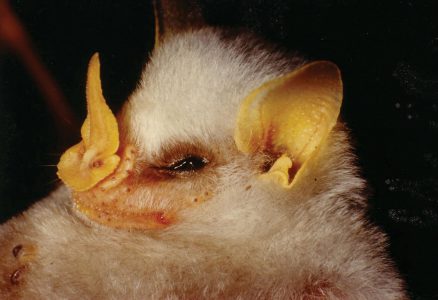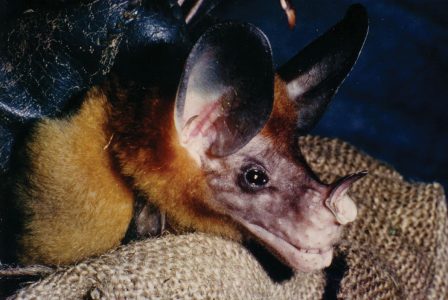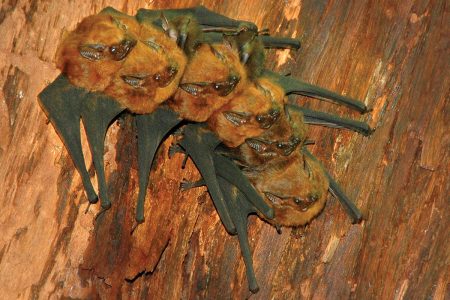WHAT ON EARTH IS A FLITTERMOUSE?
Amazing Diversity of Our Flying Mammals
By Jack Ewing
 What looks like a mouse with wings and flitters around the house? Of course it’s a bat. The name for “bat” in old English was “flittermouse”, I imagine because they somewhat resemble a mouse, and their wings flutter or flitter. In middle English it was “bakke” which evolved into “bat” in modern English in the late 1500’s.
What looks like a mouse with wings and flitters around the house? Of course it’s a bat. The name for “bat” in old English was “flittermouse”, I imagine because they somewhat resemble a mouse, and their wings flutter or flitter. In middle English it was “bakke” which evolved into “bat” in modern English in the late 1500’s.
What comes to mind when someone mentions bats? Probably nothing good. They have been associated with everything from witchcraft, darkness and Halloween to vampires and death. Terms like dingbat and batty have been use to describe people who are foolish or silly or you might hear it said that a person who acts goofy has bats in their belfry. If there are any terms or sayings that show bats in a positive light I have never heard them. These sayings and ideas all come from a time when superstition ruled people’s lives and science was in its infancy. Today we have a wealth of scientific knowledge about bats, much of which is truly fascinating, yet it is virtually unknown to the general public. For example bats comprise over 20% of all mammal species on our planet, and are the only flying mammal. According to Wikipedia there are 5416 mammalian species on earth and over 1200 of them are bats. In Costa Rica, and I suspect in most tropical countries, over 50% of mammalian species are bats. The smallest mammal in the world is a bat, Kitti’s hog-nosed bat, also known as the bumblebee bat, which weighs a mere two grams (.07 oz.), about the same as two paper clips. The fastest mammal in the world is also a bat, the Mexican long-tailed bat, which has been clocked at 160 kph (99 mph), much faster than a cheetah which has a top speed of 120 kph (74.5 mph).

 I have been around chiropterologists, or bat specialists, for 30 years, and have always been impressed by how passionate they continue to be about the subjects of their study even after years of what appears to be much the same thing. This is because bats are truly charismatic animals, and their diversity is extraordinary. In temperate climates like that of North America and Europe all of the bat species are insectivores. In Costa Rica and other tropical countries there are bats that eat fruit, nectar, pollen, fish, frogs, blood, and even other bats. I’ve already mentioned the smallest bat, but the largest new world bat (as distinct from the flying foxes) weighs nearly 100 times more at about 190 grams (.42 pounds). This is the carnivorous species known as the spectral bat which is found at Hacienda Barú among other locations in Costa Rica and feeds on birds, small rodents, and other bats.
I have been around chiropterologists, or bat specialists, for 30 years, and have always been impressed by how passionate they continue to be about the subjects of their study even after years of what appears to be much the same thing. This is because bats are truly charismatic animals, and their diversity is extraordinary. In temperate climates like that of North America and Europe all of the bat species are insectivores. In Costa Rica and other tropical countries there are bats that eat fruit, nectar, pollen, fish, frogs, blood, and even other bats. I’ve already mentioned the smallest bat, but the largest new world bat (as distinct from the flying foxes) weighs nearly 100 times more at about 190 grams (.42 pounds). This is the carnivorous species known as the spectral bat which is found at Hacienda Barú among other locations in Costa Rica and feeds on birds, small rodents, and other bats.
You may have heard the expression “blind as a bat”. In reality no species of bat is blind, but vision is not their most useful sense, hearing is. Navigation and food location are accomplished with a process called echolocation which involves emitting a high frequency sound which reflects off of nearby objects. The reflection is heard by the bat, and allows it to “visualize” its surroundings much in the same manner as radar allows us to detect flying objects we can’t see. The emitted signal is so loud it would damage the bat’s own eardrums except that special muscles close the ear canal the moment the sound is emitted and open it again in time to hear the reflected signal. Some species, like frog eating bats, listen for the distinctive sound of their prey in order to locate and kill it. Some biologists believe that this bat can even determine the species of frog from its song and avoid the poisonous or bad tasting ones.
 One thing that most people do know about bats—again it is something negative—is that some of them carry rabies. However this belief is often exaggerated to sound like all bats have rabies. Actually very few of them do; the same as very few dogs have rabies. According to the Center for Disease Control only 6% of weak or sick bats that have been captured and are tested for rabies actually carry the disease. The percentage would certainly be much lower in healthy bats. We often think of rabies when we think of so called vampire bats. That name is a misnomer as these bats don’t suck their victim’s blood, and they almost never prey on humans. Sleeping wild and domestic animals are their normal prey. A small cut is made with an extremely sharp tooth, and the bat then laps up the blood that flows from the cut. Their saliva contains an anticoagulant that causes the blood to flow freely. In 46 years of living on Hacienda Barú I have only heard of two cases of blood eating bats preying on humans. Both were during the years when large numbers of cattle were present in this area, and this abundant source of blood for the bats resulted in unnaturally large populations. A few of them turned to humans for food. A mosquito net is plenty of protection against them. Neither of the two cases I know of contracted rabies as a result of being bitten.
One thing that most people do know about bats—again it is something negative—is that some of them carry rabies. However this belief is often exaggerated to sound like all bats have rabies. Actually very few of them do; the same as very few dogs have rabies. According to the Center for Disease Control only 6% of weak or sick bats that have been captured and are tested for rabies actually carry the disease. The percentage would certainly be much lower in healthy bats. We often think of rabies when we think of so called vampire bats. That name is a misnomer as these bats don’t suck their victim’s blood, and they almost never prey on humans. Sleeping wild and domestic animals are their normal prey. A small cut is made with an extremely sharp tooth, and the bat then laps up the blood that flows from the cut. Their saliva contains an anticoagulant that causes the blood to flow freely. In 46 years of living on Hacienda Barú I have only heard of two cases of blood eating bats preying on humans. Both were during the years when large numbers of cattle were present in this area, and this abundant source of blood for the bats resulted in unnaturally large populations. A few of them turned to humans for food. A mosquito net is plenty of protection against them. Neither of the two cases I know of contracted rabies as a result of being bitten.
 As mentioned earlier almost all public knowledge and superstition about bats is negative. The good things are practically unheard of, even though there are many. For example, scientists are studying the anticoagulant called “Desmoterplase”, found in the saliva of blood eating bats, to determine if it can be synthesized and used in humans for the prevention of heart attacks and strokes. Bats eat unbelievable amounts of insects of all kinds including mosquitos that plague humans and many others that attack crops. Their role in pest control means lowered need for toxic pesticides in agriculture. Seed dispersal is another important service they provide. Once we wanted to plant a nursery of a tree called the “ojoche” but couldn’t find any seeds under the trees. Later we discovered that bats were collecting the seeds and carrying them to an old cacao plantation where they perched on the low hanging branches of the cacao trees, ate the fleshy pulp and dropped the bare seeds on the ground where they germinated. Pollination is another service bats provide for certain species of plants where they feed on the nectar from the blossoms. Bat feces, called guano, is very rich in nitrogen, and makes a great organic fertilizer. It is mined commercially from caves where bats have roosted for centuries. I used to climb into our bat inhabited attic with a whisk broom a couple of times each year to sweep up all of the guano to fertilize the gardens around our house.
As mentioned earlier almost all public knowledge and superstition about bats is negative. The good things are practically unheard of, even though there are many. For example, scientists are studying the anticoagulant called “Desmoterplase”, found in the saliva of blood eating bats, to determine if it can be synthesized and used in humans for the prevention of heart attacks and strokes. Bats eat unbelievable amounts of insects of all kinds including mosquitos that plague humans and many others that attack crops. Their role in pest control means lowered need for toxic pesticides in agriculture. Seed dispersal is another important service they provide. Once we wanted to plant a nursery of a tree called the “ojoche” but couldn’t find any seeds under the trees. Later we discovered that bats were collecting the seeds and carrying them to an old cacao plantation where they perched on the low hanging branches of the cacao trees, ate the fleshy pulp and dropped the bare seeds on the ground where they germinated. Pollination is another service bats provide for certain species of plants where they feed on the nectar from the blossoms. Bat feces, called guano, is very rich in nitrogen, and makes a great organic fertilizer. It is mined commercially from caves where bats have roosted for centuries. I used to climb into our bat inhabited attic with a whisk broom a couple of times each year to sweep up all of the guano to fertilize the gardens around our house.
I almost forgot to mention that bats are some of the most beautiful mammals in the world and also some of the ugliest. The photos tell that story.

